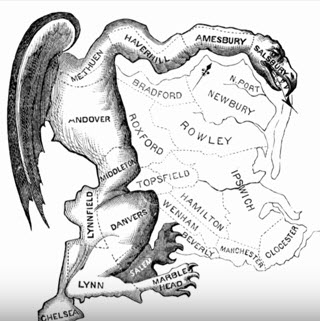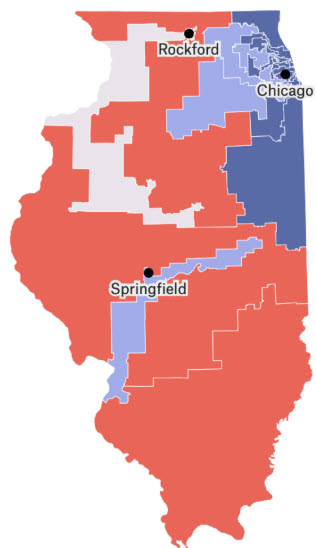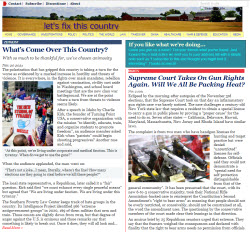The Gerrymander War and Our Disintegrating Democracy
Aug 29 2025The redistricting battle started by Texas and countered by California threatens to become a contagion that will result in the most severely extreme gerrymandering in our history.

The original gerrymander, from the
Boston Gazette of 26 March 1812,
named after Governor Elbridge Gerry
for signing a bill that redistricted
Massachusetts to benefit his Democratic
party. It was thought to look
like a salamander. Hence, Gerrymander.
Despite the Democratic Party suffering the lowest approval ratings in its history and with Democratic voter registration seriously lagging, President Trump, fearing a loss in the 2026 mid-term elections, goaded Texas into starting this war with no concern that it's yet another step in the dissolution of democracy.
It doesn't stop with Texas. Redistricting is a stratagem to rig the 2026 mid-term elections, so Trump is now pressing Indiana to do as Texas has done. J.D. Vance was sent there to meet with state legislative leaders, and a delegation was invited to the White House for some arm-twisting this past Tuesday. There was pushback from some legislators fearful of future Democratic retaliation in kind, but they will be easily overcome. Political publication The Hill called even that mild resistance "a rare exception to most other GOP-led states much more enthusiastic about redistricting", such as Florida, Ohio, Missouri.
The race is on.There's nothing new about this. Gerrymandering has been with us since the early 1800s, is manifestly undemocratic, the Supreme Court avoids dealing with it, and Congress leaves it to the states. For Trump, the grail is to obliterate the Democratic Party's representation in Congress.
It doesn't have to be this way. We could easily have a pure democracy if it weren't for the political parties' lust for power. We'll explain later.
illiberal artElection maps are drawn by state legislatures with the party in power deciding where the lines are drawn. Thus they exploit a self-serving process that perpetuates themselves in office — both in state posts and congressional seats — to the exclusion of the opposition party or parties.
Whereas once humans with pencils and erasers did their best to figure out where the voters lived and where to draw lines around them, computer software has optimized making districts impregnable, turning gerrymandering into anathema for the democratic process.
Map designers or software algorithms employ the techniques of "cracking" and "packing" to neuter the votes of the opposition party. Cracking splits areas where the opposition predominates, spreading their votes into districts where they will be safely outnumbered and have no effect. Packing often surrenders a district to the opposition, but crams it with as many opposition voters as possible to purge them from surrounding districts, leaving behind the controlling party's voters to predominate.

An example of gerrymander's
absurdity is Illinois's notorious
contortions, the across state
squiggle (Springfield) and the
northwest contrivance (Rockford).
The Republican motive is historically to isolate Blacks, who vote overwhelmingly Democratic, although less so in 2024. An example is when the Alabama legislature packed a district which already had a 72% majority of Blacks with 16,000 more. "Bleached of their reliable Democratic voters, the surrounding districts become safe for Republicans", as a Wall Street Journal opinion writer put it. Supreme Court Chief Justice John Roberts called it the “sordid business of divvying us up by race”.
Insidious as well for being entirely undemocratic. Voters who support the opposition candidate in district gerrymandered against him or her are entirely disenfranchised. Unlike in a competive district, those voters' votes count not at all. They never have a say, which suits Trump and Vance just fine in their redistricting campaign.
the worst get a leg upGerrymandering affects political candidates as well, distorting the democratic process. In a district where there is competition between left and right, it causes candidates to center their positions somewhat, to come across as reasonable, whereas gerrymandering, by effectively neutering the opposition party candidate, puts an incumbent at risk of others in his party. In the primary elections that select a party's candidate, a representative running for re-election is made vulnerable to the threat of a more extreme challenger of his or her party. Woe betides incumbents guilty of any deviance from doctrine while in office. They will be sent packing, because it is the most ideologically extreme who come out to vote in the primaries and they vote for the extreme challenger.
supreme court would rather notGerrymandering inspires lawsuits. You would think the business of elections — the foundation of democracy — would be of supreme importance to the Supreme Court to rule on such suits. The opposite is true. Chief Justice John Roberts has shown an aversion to hearing such squabbles, to be dragged in to strike down one after another dispute and necessarily favor one political party over the other.
In 2019, the Supreme Court dealt with a couple of cases and decided that, while they would step in when gerrymandering appears to be racially motivated in violation of Section 2 of the 1965 Voting Rights Act — cracking or packing Black districts, say — they would no longer take on cases of partisan political battles, no matter the threat to democracy of leaving state legislatures free to eviscerate the opposition party. In a 2016 case of racial discrimination against North Carolina and Virginia, Justice Elena Kagan had said about gerrymandering, "If it's politics, it's fine. If it's race, it's not".
The Court has as an excuse: Article I, Section 4, of the Constitution gives control of "The Times, Places and Manner of holding Elections for Senators and Representatives" to the state legislatures. No sign of checks and balances in that proviso.
The Supreme Court has already done its own eviscerating. In 2013 it did away with Section 5 of the Voting Rights Act which required a number of bad actor states — mostly in the South — to "pre-clear" with the Justice Department any change in their election laws. Chief Justice Roberts wrote, “The historic accomplishments of the Voting Rights Act are undeniable, but the Act now raises serious constitutional concerns”, irrespective that Congress had re-authorized it four times. As recently as 2006 it was passed by 390 to 33 in the House and 98 to 0 in the Senate. Section 2 still stands. It prohibits…
"any voting standard, practice, or procedure that results in the denial or abridgement of the right of any citizen to vote on account of race, color, or membership in a language minority group".
In a case to be heard a second time in October, a group calling itself "non-African American" voters has challenged a Louisiana map that, out of the state's six congressional districts, outlines two districts that have Black majorities in consideration that the state's population is one-third Black. The plaintiffs argue that this is unconstitutional racial gerrymandering.
The Court, it is suspected, is likely to be receptive. Justices Neil Gorsuch and Clarence Thomas have said that Blacks figuratively herded into districts drawn to prevent their influence elsewhere are still able to vote, so what's been abridged? It is widely suspected that the Supreme Court will overturn the Voting Rights Act altogether. The safeguards against discriminatory voting regulations will be gone and Jim Crow bigotry will arise anew.
up to congressThat Article I, Section 4 sentence about "Times, Places and Manner" being for states to decide goes on to say, "but the Congress may at any time by Law make or alter such Regulations." Pamela Karlan, a professor at Stanford Law School, once made the point that, "Congress could pass a law tomorrow to move to a system of proportional representation". That would rid the country of the whole disreputable practice of self-interested politicians drawing maps with the sole purpose to keep themselves in office.
the fixThe law requires each congressional district to have approximately the same population. And it requires that a district be contiguous; it cannot be made of separate pieces. Population densities vary across a map, rivers and lakes intrude, highways bisect, so dividing a state into the number of districts that matches the number of congressional representatives that its population allows, with each district having the same number of people, is more than a doodle on a napkin.
Sadly, software companies have obligingly taken redistricting to extremes by creating the tools to assist states in gerrymandering the opposition party virtually out of existence. More's the pity that the same software logic could be repurposed to rid us of gerrymandering for good.
Handed census data, software code would begin by dividing a state into the nearest to equal population-size areas. Algorithms then recursively adjust each area's shape and size with attention to cities and towns and geographical features, but with zero regard to political parties, ethnic groups, and voting patterns. Job done. The wasteful and contentious lawsuits and court cases would vanish.
And it has been done. Now many times, but first years ago by a Massachusetts software engineer, appalled by the corruption of gerrymandering, named Brian Olson. He created software — open source that you could even run on your home computer — that could apply the same uniform algorithms to the census maps of all 50 states. He went on to make this something of a crusade, replete with TED talk.
But no attention is ever paid. The Supreme Court justices have lamented no one has come up with a standard by which overly partisan gerrymandering could be eliminated. Let's Fix This Country even sent a letter, individually addressed to each justice, to make them undeniably aware of this solution. And there is a standard in Article IV, Section 4, says:
"The United States shall guarantee to every State in this Union a Republican Form of Government"
If states become so corrupted that the votes of subsets of their citizenry are repressed so as to have no count, it is Congress's job to step in.
And it has. There exists the Freedom to Vote Act, originally called the For the People Act, intended to:
Expand voting rights, change campaign finance laws to reduce the influence of money in politics, ban partisan gerrymandering, and create new ethics rules for federal officeholders.
The Democratic majority in the House passed the bill in 2019 by a vote of 234 to 193. It was blocked from receiving a vote in the Senate by, well, of course, Republican Majority Leader Mitch McConnell.
Democrats tried again in 2021. It again passed in the House by 220 to 210. Senate Republicans blocked the bill with a filibuster. And so it goes in our America.
Please subscribe if you haven't, or post a comment below about this article, or
click here to go to our front page.

